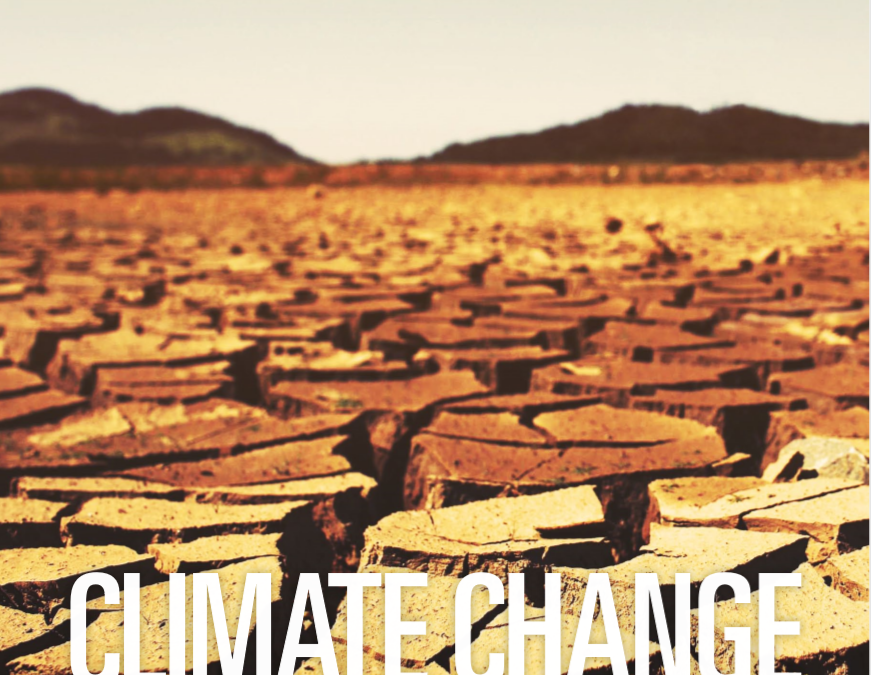Water footprint
This month of June has been marked by various events and episodes related to global climate change, energy efficiency and the environment. One of them has been the celebration of the Green Week. Promoted by the European Union, this week is devoted to announcing those projects related to the LIFE Programme, which funds R&D&I projects in the field of environment, the EUSEW (Sustainable Energy Week) and the Encyclical by Pope Francis, among others.
The Green Week is already an essential occasion for those agents involved in R&D&I for the environment. If the previous edition was devoted to circular economy, this edition has Nature at the core of the analysis. Understanding that human beings depend on it to obtain nourishment, energy, raw material, clean air and drinking water, the organizers of the biggest annual conference related to environmental policy in Europe devoted this week to debate about the best methods to protect this source of resources and survival. Besides, on the basis that the environment is a source of wealth and employment creation, more than 4,000 people attended the Conference in Brussels to share experiences and setting new goals.
This year, the Green Week motto has been ‘Nature – our health, our wealth”
In a similar context, the EU celebrated the EUSEW, an event on R&D&I for energy efficiency that has been taking place since 2006, experiencing an increasing involvement of the community every year. Besides the high-level conferences that take place in Brussels, almost 700 ‘energy days’ were celebrated this year in Europe. These open days, informative conferences and workshops dedicated to the implementation of renewable solutions are, unquestionably, the most efficient means of involving the community in every action against global climate change that is being executed in the European Union.
The European Commission has been committing resources towards research and the implementation of innovative technologies to reduce energy use, improve the quality of air and water, recovering waste of any kind and decarbonizing the economy through the use of renewable energy. However, without the collaboration of the community with everyday actions and more sustainable philosophies of life, these efforts will not bear a decisive and shortterm outcome. This is the reason why awareness and information campaigns of this kind are increasing in number and winning supporters in cities and districts
Yet, if there has been a great landmark in the battle against global climate change these last weeks, it has been without a doubt the publication of the Laudato si’, first Encyclical of Pope Francis; this could be described as an unprecedented ecological declaration in the Catholic Church. Relying on the scientific consensus, the Supreme Pontiff assumes some fundamental truths: that the Earth’s deterioration is real and verifiable, and that this deterioration is caused by man’s actions. Two facts that a significant sector of the world’s population still refuses to accept.
Given this context with the Earth as the special protagonist, CARTIF also developed various actions related to the protection of the environment, always within the field of its research activity.
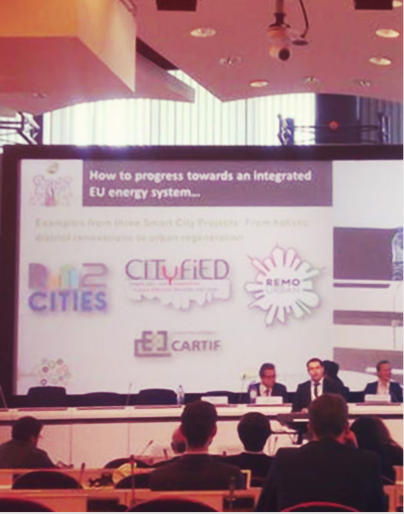
Dozens of people visited the demonstrators from CARTIF Smart City projects during EUSEW 2015
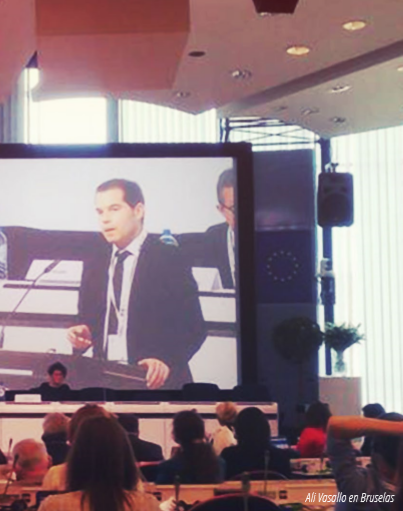
EUSEW 2015
Dozens of people visited the demonstrators from CARTIF Smart City projects during EUSEW 2015.
The intention of these Doors Open Days (OpenHouse) was to invite the European citizens to know the work and the main changes that are being made in those cities and districts participant in Smart City projects.
Among the projects led by CARTIF, there were open days in every demonstrator from the CITyFiED project. In Spain, the Torrelago district in Laguna de Duero (Valladolid) received hundreds of schoolchildren, neighbors and professionals of energy efficiency. They visited the biomass boiler room that already supplies the heating system of 500 houses in the district, and the first block of apartments in which the first building envelope for thermal insulation has been installed. At the Swedish demonstrator, in the Linero district (Sweden), and in the Turkish borough of Soma (Manisa), there was full attendance to the guided tours led by the project members.
The R2CITIES project demonstrators also joined the EUSEW 2015 OpenHouse initiative. The Genoese district of Lavatrici and the Turkish of Kartal-Istanbul showed their progress on the project.
More than 20,000 European citizens are benefitting or will benefit from the Smart City projects in which CARTIF will be participant until 2019. Besides the increase in home comfort, the reduction in energy spending and the improvement of your quality of life, these projects seek to reach an important reduction of pollution emissions and an efficient management of energy resources.
Precisely, the implementation of energy systems in the urban sphere and their relations to other systems, was the topic of Ali Vasallo’s conference, researcher in CARTIF’s Energy Division and coordinator of the CITyFiED project
Vasallo presented the actions that are being executed in the Smart City projects led by CARTIF in the context of the session ‘Towards an integrated energy system. Energy System Integration from local to EU wide.’ The conference, which took place in Brussels within the framework of the EUSEW, gathered the main European authorities in the field of energy, from Miguel Arias, European Commissioner in the Climate Action and Energy sector, to Dominique Ristori, Director General for Energy in the European Union.
EFE FORUM Technology and Environment
Two of the most consolidated research lines in CARTIF are the Environmental Technologies and Sustainable Management lines. In this context, our teams develop projects on the three cores of circular economy: water, waste and air. The 12 LIFE projects that the Centre will participate in between 2013 and 2018 are also based on these topics. To advertise these projects, CARTIF organized an informative event in partnership with Agencia EFE (first Spanish news agency in the world)
The actions against climate change were the protagonist at the EFE FORUM CARTIF
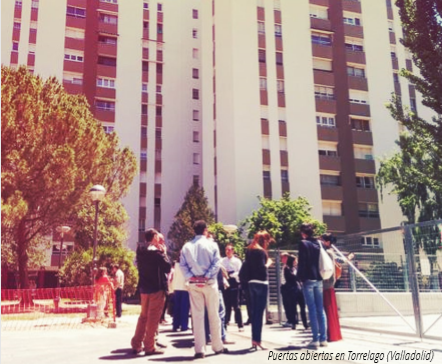
The actions against global climate change were the protagonists in the event coordinated by CARTIF and Agencia EFE. The opening speech was made by Susana Magro, Director General of the Spanish Office of Climate Change, who claimed that “all the policies related to waste, energy, water, biodiversity, including the economic and social policies will have climate change policies as the starting point.” Arturo Larena, Director of EFEverde, concluded the convention.
Magro placed particular emphasis on encouraging companies to “invest in R&D&I, for it will be the key towards a low-carbon economy,” and she claimed that “the policies to face climate change will mark the beginning towards a zero emission world.”
Business owners and public administrations that attended the event thought likewise. Esteban Pérez, technical director of Turqueplast, explained the importance of earning environmental together with economic profit from investments in R&D. On the other hand, María José Blázquez, technical director of the Integrated Management System for the Collection of Drug Product Containers (SIGRE), reminded us that her nonprofit organization invests 20% of its budget in environment R&D&I of the pharmaceutical industry, especially in ecodesign.
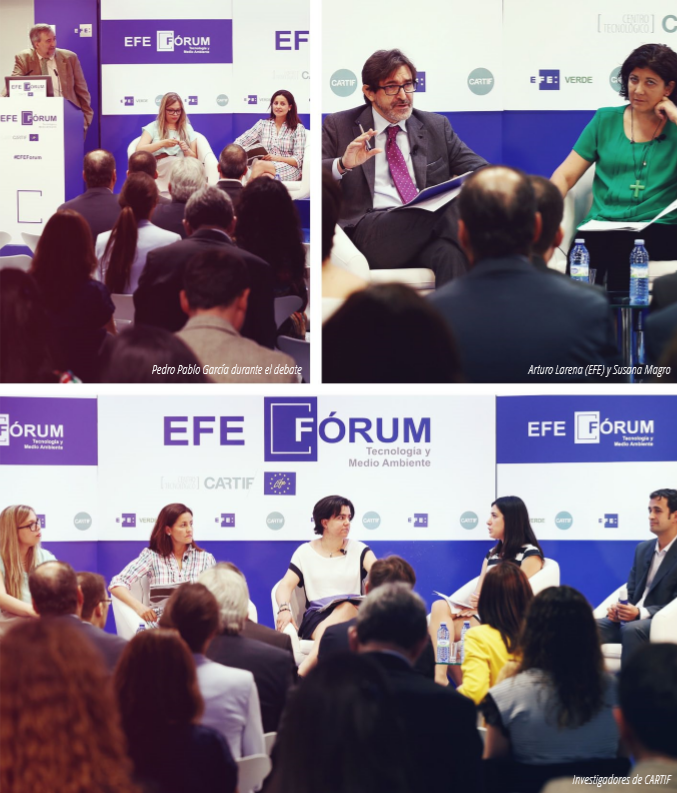
As for the improvements in R&D&I in the environmental field, members of the CARTIF research team presented some of the projects that search for solutions to specific problems related to waste management (and their valuation), air pollution and the water cycle.
The great challenges: the optimal management of waste, water, air and energy
One of the major challenges of the actions against global climate change is fighting air pollution. Among the functioning projects in CARTIF, two of those are distinctive for their search for solutions to improve the air quality. The EQUINOX project attempts to make a largescale demonstration of a system that captures nitrogen oxides from the air on road areas and transforms them into an innocuous substance that tolerates rainwater and washing-down.
The idea is to combine a new development of lowcost air quality sensors, which has allowed creating a dense network of air quality and combining it with this air treatment technology based on titanium dioxide. It will be tested in an area of 80,000m2 in the Chamberí district (Madrid) and the results obtained will be measurable from 2016.
Another project that attempts to fight air pollution is DIOXDETECTOR, whose researchers are developing a new technique to quantify dioxins in the air, ground, water and biota. This technique will allow detecting lower levels and in a shorter span of time, thus working more efficiently to obtain the actual spread of dioxins in nature. Besides, it will be a reliable tool so the air quality managers can make the right decisions.
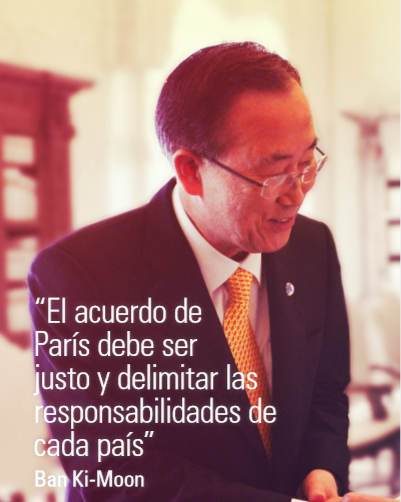
Water is one of the scarcest natural resources and its right management is object of great preoccupation from companies and public administrations. In the SMART HOSPITAL project, managing the water cycle correctly in hospitals will reduce water use by 35% and waste pollution by 20%.
The use of water remains at a high level in the construction sector. Reducing the water footprint by 5% and the carbon footprint in those rail network projects by 10% is the goal of the HUELLAS project, based on life cycle assessment instruments that will allow developing tools and methodologies to optimize decision-making before causing an irreparable environmental damage.
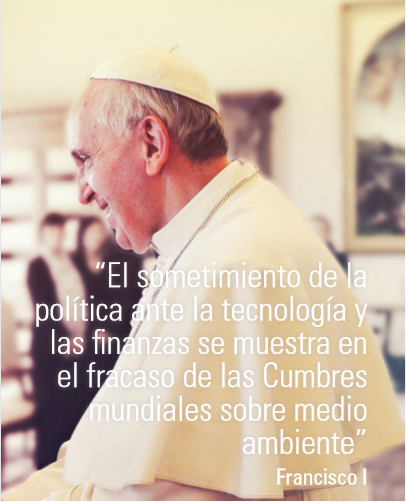
And, in the field of waste management and valuation, the CARTIF teams are working simultaneously in different sectors: agricultural and livestock waste, plastic waste and biomass waste.
Among the most innovative, in the livestock sector two projects are working on the same matter: wastes derived from porcine. In the case of the VALPORC project, it covers those wastes from category 2 carcasses (those that cannot be used either for human consumption or for animal consumption), which only in Spain mean 150,000 ton/year. The options to reuse them are: turning them into biofuel and organic fertilizers.
In the MIX FERTILIZER project, the waste to recover is the porcine manure, transforming it into a new mixed-base (organic and inorganic) fertilizer and of slow release. This would be an excellent option when a manure-treatment plant business is in a low-activity phase facing the revocation of state funds.
UN Conference on Climate Change: COP 21
Five months before the UN Conference on Climate Change in Paris – COP21 – the international community believes it is possible to achieve a binding global agreement to answer global warming.
The commitment of the three world economies – the United States, the European Union and China – to achieve a zero emission development, the increase of the use of clean energy and the demands by citizens and leaders like Pope Francis, allow a relative optimism. However, it is fundamental that the agreement on the table is impartial and that the responsibilities of each country are clearly identified, given that they are neither equally guilty of global warming nor equally capable of responding. The ultimate goal of the international community is that global warming does not exceed two degrees (Celsius) concerning the pre-industrial levels, something that scientists and technologists are contributing towards thanks to their respective projects.
In CARTIF, we remind the words from Pope Francis and “invite everyone to stop and think about the environmental challenges.”
